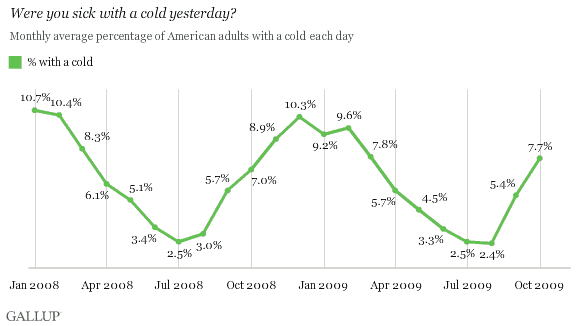PRINCETON, NJ -- Flu cases in the U.S. continue to tick higher, with an average of 2.7% of adults in October reporting that they were "sick with the flu yesterday," compared to 1.9% in September and 2.0% in October 2008.

"The average percentages of American adults reporting the flu for both September and October this year are above the averages for last year's comparable months."
The surveys a random sample of about 1,000 adults each day, or roughly 30,000 adults a month, on a wide range of topics related to health and wellbeing. One of the daily questions asks, "Were you sick with any of the following yesterday?" and specifies four illnesses, among them "the flu" and "a cold."
The average percentages of American adults reporting the flu for both September and October this year are above the averages for last year's comparable months. The rate of increase from September to October is also higher than was the case last year, although the absolute level of increase remains slight so far. Overall, the data do not yet show the major increase in self-reported flu incidence that some have feared. The highest daily "flu yesterday" monthly average since the Gallup-Healthways Well-Being Index began in January 2008 was 4.3%, in February 2008.
The Gallup-Healthways measure is not cumulative, so it cannot be used to estimate the total percentage of adults who have had the flu at any time so far this season; it reports only the average percentage who say they had the flu the day before they were interviewed.
The self-reported incidence of colds among U.S. adults also increased last month, from a daily average of 5.4% during September to 7.7% in October.

The jump in October compared to September follows the pattern seen last year, as reports of colds rose from a daily average of 5.7% in September 2008 to 7.0% in October 2008. As was the case for self-reports of flu, the self-reports of colds over the last two months are running slightly higher than last year, and the rate of increase from September to October this year is also higher.
It is important to remember that the Gallup-Healthways question measures self-reported incidence of having a cold or the flu. This is not an objective measure of actual symptoms or the physiological, medically confirmed presence of disease, but rather a measure of a respondent's subjective assessment. Given the widespread publicity surrounding the H1N1 or swine flu this season, it is possible that some Americans are more sensitive to minor symptoms and may be more likely to define a cough, runny nose, or mild sore throat as "the flu" or "a cold" this year than they were last year.
includes a comprehensive analysis by demographic group.
���۴�ýwill continue to track the self-reported incidence of colds and flu over the coming months to gauge the real-time impact of flu season, and will continue to gauge worry about H1N1.
Survey Methods
Results are based on telephone interviews with 31,253 national adults, aged 18 and older, conducted in October 2009. Previous monthly samples are all near n=30,000 per month. For monthly results based on the total sample of national adults, one can say with 95% confidence that the maximum margin of sampling error is ±0.6 percentage points.
Interviews are conducted with respondents on land-line telephones (for respondents with a land-line telephone) and cellular phones (for respondents who are cell-phone only).
In addition to sampling error, question wording and practical difficulties in conducting surveys can introduce error or bias into the findings of public opinion polls.
About the Gallup-Healthways Well-Being Index™
The Gallup-Healthways Well-Being Index is the first and largest survey of its kind, with 1,000 calls a day, seven days a week. It is the official statistic for Wellbeing in America, giving a daily measure of people's wellbeing at the close of every day based on the World Health Organization (WHO) definition of health as not only the absence of infirmity and disease but also a state of physical, mental and social wellbeing. The Well-Being Index will be a daily measure determining the correlation between the places people work and the communities in which they live, and how that and other factors impact their wellbeing. Additionally, the Well-Being Index will increase the understanding of how those factors impact the financial health of corporations and communities. Learn more about the .
